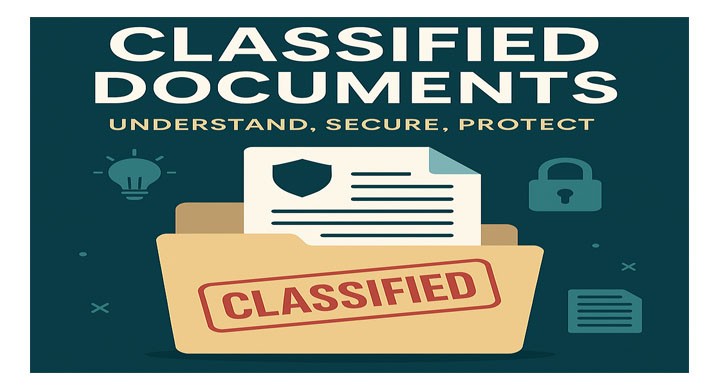Classified Documents: What They Are, Why They Matter, and How They’re Protected
Grisha July 26, 2025 No Comments

Classified Documents
In the age of data leaks, digital surveillance, and cyber espionage, not all information is meant for everyone. Some data holds national importance, corporate value, or legal sensitivity—and needs to be handled with extreme care. That’s where classified documents come in.
Whether you’re in government, defense, law, or business, understanding what classified documents are—and how to treat them—is critical to managing risk and maintaining trust.
What Are Classified Documents?
Classified documents are files, papers, or digital records that contain sensitive information protected by law or internal policy. Unauthorized access to these documents could result in damage to national security, public safety, or an organization’s strategic interests.
These documents are officially marked and stored with restricted access levels, and mishandling them can carry serious consequences—including fines, job loss, or even prosecution.
Common Levels of Classification
Classified documents are divided into different levels depending on the potential harm their exposure might cause. Here’s a breakdown using standard U.S. and international classification levels:
1. Top Secret
-
Most sensitive level.
-
Unauthorized disclosure could cause exceptionally grave damage to national security.
-
Example: Nuclear codes, military operations.
2. Secret
-
Exposure could cause serious damage.
-
Example: Defense strategies, undercover agent identities.
3. Confidential
-
Exposure could cause damage to national or organizational interests.
-
Example: Diplomatic communications, internal company strategies.
4. Restricted / Internal Use Only
-
Not officially classified under national laws, but still sensitive.
-
Example: HR files, internal reports, client contracts.
What Information Gets Classified?
Classified documents can include:
-
Government intelligence reports
-
Military plans and operations
-
Surveillance data
-
Business trade secrets
-
Legal investigations
-
Diplomatic communications
-
Cybersecurity protocols
-
Proprietary algorithms or designs
If the unauthorized release of a document could lead to harm, it’s a candidate for classification.
How Are Classified Documents Handled?
Handling classified documents requires strict compliance with security policies and access control procedures.
Key Handling Measures:
-
Clearance Verification – Only those with proper clearance can view the documents.
-
Access Logs & Tracking – Every view, edit, or transfer is recorded.
-
Physical Security – Locked safes, secure rooms, badge access.
-
Digital Encryption – Military-grade encryption for digital files.
-
Destruction Protocols – Shredding, burning, or wiping devices when data is no longer needed.
-
Training & Audits – Employees are regularly trained on handling protocols and violations.
Risks of Mishandling Classified Documents
Failing to properly protect classified materials can have serious consequences:
-
National security threats
-
Legal action or fines
-
Data breaches or leaks
-
Reputational damage
-
Cyberattacks or espionage
-
Loss of contracts or funding
Famous leaks like those involving Edward Snowden, Chelsea Manning, or WikiLeaks exposed the real-world impact of mishandled classified data.
Are Classified Documents Ever Declassified?
Yes. Over time, many classified documents lose their sensitivity and may be declassified, either automatically or after review.
For example, in the U.S., documents are typically reviewed for declassification after 25 years unless they still pose a risk. This process allows for transparency while protecting active interests.
Classified Documents in Business & Law
While the term “classified” is often associated with governments, businesses and law firms also deal with sensitive documents, such as:
-
Client NDAs and legal contracts
-
Internal investigations
-
R&D documents and prototypes
-
Financial reports before public release
-
Employee data and disciplinary files
These might not be “classified” in the national security sense, but they’re treated with similar precautions.
Best Practices for Managing Classified Documents
-
Use encrypted file storage and communication tools
-
Implement role-based access control
-
Train employees on document handling policies
-
Maintain a document classification policy
-
Destroy expired data securely
-
Audit regularly for compliance
Bonus: Promote Your Services Safely with VyaparGrow
Not all information should be hidden—but your business shouldn’t be either.
If you’re looking to promote your services, sell products, or hire talent while keeping control over your message, use a secure and trusted platform like VyaparGrow.
Why VyaparGrow?
-
100% Free Ad Posting
-
No data misuse or hidden charges
-
Perfect for services, jobs, and local business offers
-
Easy, fast, and mobile-friendly
📢 Post your ad today at VyaparGrow.com and reach real people without compromising security.
FAQs About Classified Documents
What is a classified document?
A classified document contains sensitive information that is restricted to authorized individuals or systems for security or privacy reasons.
How do you know if a document is classified?
It will be clearly marked with labels like Top Secret, Confidential, or Restricted. These markings are defined by legal or organizational policy.
Can a company have classified documents?
Yes. While they may not be “national security” classified, businesses use terms like confidential, proprietary, and internal only to control sensitive data.
What happens if you leak classified information?
Depending on the severity, leaking classified data can lead to job termination, lawsuits, fines, or criminal charges.
Final Thought
Classified documents aren’t just about secrecy—they’re about responsibility. Whether you’re working with government files, client records, or internal strategies, knowing how to handle sensitive data is essential.
Stay informed. Stay secure. And when you’re ready to share the right message with the world—do it smart, do it free, and do it on VyaparGrow.
Leave a Comment
Your email address will not be published. Required fields are marked. *